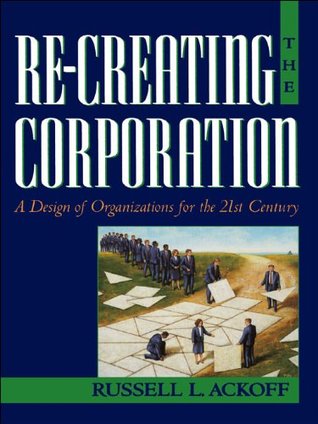Kindle Notes & Highlights
Downsizing encumbers tomorrow’s growth for a quick fix today”
My experience indicates that larger improvements can be obtained by focusing on quality of work life than on quality of products or services.
Getting rid of what one does not want provides no assurance of getting what one does want.
The solution to a problem conceptualized as removal of a defect or deficiency may be worse than the defect or deficiency that it removes. Recall Prohibition’s effort to get rid of alcoholism and the current effort to get rid of crime. Improvement programs should be directed at getting what organizations and their stakeholders want, not at getting rid of what they do not want. Idealized design defines what is wanted.
There are a number of techniques for enhancing creativity (Ackoff and Vergara, 1981), for example, lateral thinking (de Bono, 1973), synectics (Gordon, 1961), brainstorming (Osborn, 1953), TKJ
(Getzels and Csikszentmihalyi, 1971), conceptual block busting (Adams, 1974), and idealized design. Elsa Vergara (1976) compared these techniques experimentally and found that idealized design outperformed the others significantly.
no business can survive without awareness of the relative performance of its competitors.
Development, in contrast to growth, is a mental rather than a material process. Because development is primarily a matter of learning and because one person or group cannot learn for another, one person or group cannot develop another. The only kind of development possible is self-development, but such social systems as governments and corporations can and should encourage and facilitate the development of all their stakeholders.
In The Republic, Plato asserted that art—the product of creative activity—was a potentially dangerous stimulant that threatens the stability of a society. It stimulates visions of an allegedly better life than the one being experienced. Therefore, Plato saw art as a disruptive social influence. In contrast, Aristotle saw art as cathartic, a palliative for dissatisfaction, hence a producer of social stability and contentment. He saw art as recreation, something from which one extracts pleasure here and now.
Decisions should be made by consensus of all those who are directly affected by the decisions, the decision’s stakeholders, with the exceptions noted below.
an environment in which employees can accept and execute their responsibilities with confidence and finesse. He must communicate with his employees, imparting the company’s vision and listening to what they need to make that vision a reality. To succeed … he must be a visionary, a strategist, an informer, a teacher, and an inspirer.
Inspiring visions are works of art. Effective leaders are artists.
Implementation without inspiration is management or administration, not leadership.
An inspiring, courage-evoking vision requires a mobilizing idea at its core. Such an idea need not appear to be realizable,
He must make the pursuit of the vision fun as well as fulfilling. Therefore, the major developmental aspect of leadership is aesthetic.
Second, leaders have an obligation to enable their subordinates to do better tomorrow than the best they can do today, that is, to provide them with opportunities for continuous development through on- and off-the-job education and training. Leaders must be educators and encourage and facilitate education by others.
Mistakes are the ultimate source of learning, which occurs when mistakes are identified, diagnosed, and corrected.
An organization can develop without growing, but growth can provide the resources that facilitate development. Growth is primarily a matter of economics, but development also involves science, technology, and education; ethics and morality; and aesthetics.


